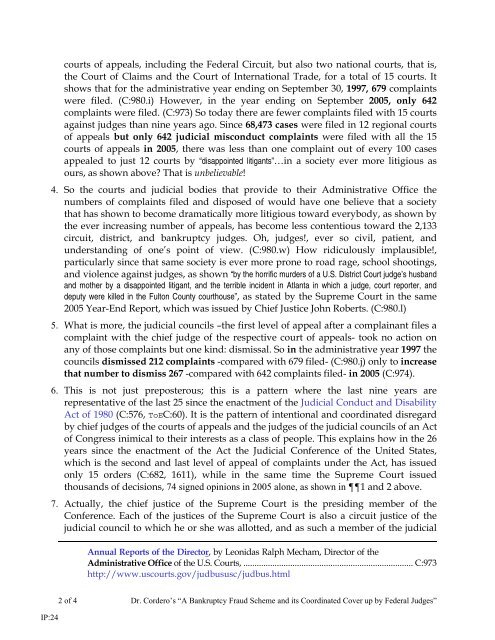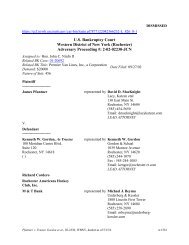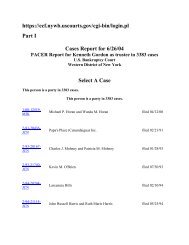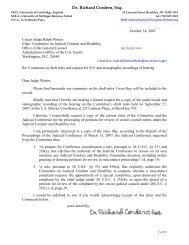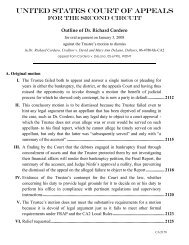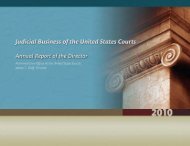Dr. Richard Cordero, Esq. Synopsis of an Investigative Journalism ...
Dr. Richard Cordero, Esq. Synopsis of an Investigative Journalism ...
Dr. Richard Cordero, Esq. Synopsis of an Investigative Journalism ...
You also want an ePaper? Increase the reach of your titles
YUMPU automatically turns print PDFs into web optimized ePapers that Google loves.
courts <strong>of</strong> appeals, including the Federal Circuit, but also two national courts, that is,<br />
the Court <strong>of</strong> Claims <strong>an</strong>d the Court <strong>of</strong> International Trade, for a total <strong>of</strong> 15 courts. It<br />
shows that for the administrative year ending on September 30, 1997, 679 complaints<br />
were filed. (C:980.i) However, in the year ending on September 2005, only 642<br />
complaints were filed. (C:973) So today there are fewer complaints filed with 15 courts<br />
against judges th<strong>an</strong> nine years ago. Since 68,473 cases were filed in 12 regional courts<br />
<strong>of</strong> appeals but only 642 judicial misconduct complaints were filed with all the 15<br />
courts <strong>of</strong> appeals in 2005, there was less th<strong>an</strong> one complaint out <strong>of</strong> every 100 cases<br />
appealed to just 12 courts by “disappointed litig<strong>an</strong>ts”…in a society ever more litigious as<br />
ours, as shown above? That is unbelievable!<br />
4. So the courts <strong>an</strong>d judicial bodies that provide to their Administrative Office the<br />
numbers <strong>of</strong> complaints filed <strong>an</strong>d disposed <strong>of</strong> would have one believe that a society<br />
that has shown to become dramatically more litigious toward everybody, as shown by<br />
the ever increasing number <strong>of</strong> appeals, has become less contentious toward the 2,133<br />
circuit, district, <strong>an</strong>d b<strong>an</strong>kruptcy judges. Oh, judges!, ever so civil, patient, <strong>an</strong>d<br />
underst<strong>an</strong>ding <strong>of</strong> one’s point <strong>of</strong> view. (C:980.w) How ridiculously implausible!,<br />
particularly since that same society is ever more prone to road rage, school shootings,<br />
<strong>an</strong>d violence against judges, as shown “by the horrific murders <strong>of</strong> a U.S. District Court judge’s husb<strong>an</strong>d<br />
<strong>an</strong>d mother by a disappointed litig<strong>an</strong>t, <strong>an</strong>d the terrible incident in Atl<strong>an</strong>ta in which a judge, court reporter, <strong>an</strong>d<br />
deputy were killed in the Fulton County courthouse”, as stated by the Supreme Court in the same<br />
2005 Year-End Report, which was issued by Chief Justice John Roberts. (C:980.l)<br />
5. What is more, the judicial councils –the first level <strong>of</strong> appeal after a complain<strong>an</strong>t files a<br />
complaint with the chief judge <strong>of</strong> the respective court <strong>of</strong> appeals- took no action on<br />
<strong>an</strong>y <strong>of</strong> those complaints but one kind: dismissal. So in the administrative year 1997 the<br />
councils dismissed 212 complaints -compared with 679 filed- (C:980.j) only to increase<br />
that number to dismiss 267 -compared with 642 complaints filed- in 2005 (C:974).<br />
6. This is not just preposterous; this is a pattern where the last nine years are<br />
representative <strong>of</strong> the last 25 since the enactment <strong>of</strong> the Judicial Conduct <strong>an</strong>d Disability<br />
Act <strong>of</strong> 1980 (C:576, ToEC:60). It is the pattern <strong>of</strong> intentional <strong>an</strong>d coordinated disregard<br />
by chief judges <strong>of</strong> the courts <strong>of</strong> appeals <strong>an</strong>d the judges <strong>of</strong> the judicial councils <strong>of</strong> <strong>an</strong> Act<br />
<strong>of</strong> Congress inimical to their interests as a class <strong>of</strong> people. This explains how in the 26<br />
years since the enactment <strong>of</strong> the Act the Judicial Conference <strong>of</strong> the United States,<br />
which is the second <strong>an</strong>d last level <strong>of</strong> appeal <strong>of</strong> complaints under the Act, has issued<br />
only 15 orders (C:682, 1611), while in the same time the Supreme Court issued<br />
thous<strong>an</strong>ds <strong>of</strong> decisions, 74 signed opinions in 2005 alone, as shown in 1 <strong>an</strong>d 2 above.<br />
7. Actually, the chief justice <strong>of</strong> the Supreme Court is the presiding member <strong>of</strong> the<br />
Conference. Each <strong>of</strong> the justices <strong>of</strong> the Supreme Court is also a circuit justice <strong>of</strong> the<br />
judicial council to which he or she was allotted, <strong>an</strong>d as such a member <strong>of</strong> the judicial<br />
Annual Reports <strong>of</strong> the Director, by Leonidas Ralph Mecham, Director <strong>of</strong> the<br />
Administrative Office <strong>of</strong> the U.S. Courts, ............................................................................ C:973<br />
http://www.uscourts.gov/judbususc/judbus.html<br />
2 <strong>of</strong> 4 <strong>Dr</strong>. <strong>Cordero</strong>’s “A B<strong>an</strong>kruptcy Fraud Scheme <strong>an</strong>d its Coordinated Cover up by Federal Judges”


